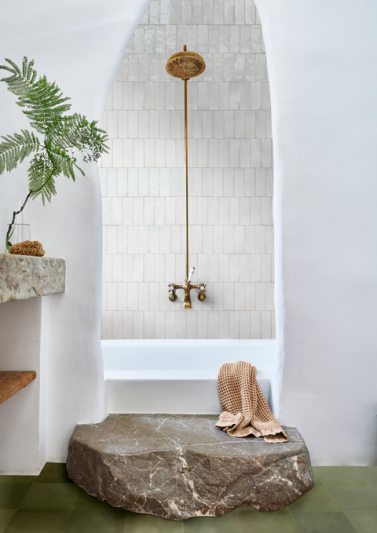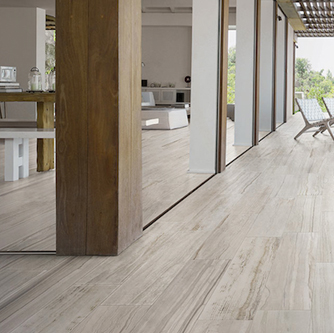
The pursuit of modern bathroom design for your next newbuild or renovation may seem elusive in an age where the definition of modern has changed over many decades. It’s generally accepted that minimal design aesthetics and functionality have characterised modern design since the 2000s but are certainly not restricted to clinical and bare-looking appearances. The desire to come home to a clutter-free bathroom is not lost on many who, in the fast-paced world that we live in, wish for a place to relax and rejuvenate.
Tiles play a significant design and functional role in any bathroom based on the surface area they cover. While it may be easier said than done, creating a modern look without feeling clinical is not impossible to achieve with these tile considerations and tips.
Key Elements of Modern Design in Bathrooms
Modern bathroom design is distinguished by several key features:
- Sleek lines and minimalist layouts: The use of clean lines and uncluttered spaces create a visually expansive feel. Conversely, too many decorative elements or contrasting patterns and colours can clutter the space and detract from a minimalist aesthetic.
- Neutral colour palettes: Soft, muted tones dominate, often complemented by natural textures, to foster a serene and calming environment. This also gives you greater flexibility when deciding between other tiles and materials.
- Functionality: Modern design prioritises materials and accessories that don’t just look good but are also functional. For example, choosing porcelain tiles instead of natural stone can reduce upkeep and maintenance while still giving you a beautiful look.

Modern clean lines contrast the soft stone textures and neutral colour palette of this bathroom. Grande Fior Di Bosco, 6mm, made in Italy.
Choosing Tiles for a Modern Bathroom Aesthetic
When selecting tiles to complement a modern bathroom design, it’s crucial to consider how your choices will enhance the space’s functionality and aesthetic appeal. Here are some key considerations:
- Size matters: Large format tiles, such as our 600x600mm or 600x1200mm, contribute to a seamless look, minimising the appearance of grout and visually expanding the space.
- Rectified edge: All our floor and wall tiles (excluding features) have rectified edges to minimise the appearance of grout lines for a clean and seamless look.
- Colour: Opt for neutral tones or muted colours to maintain a tranquil atmosphere.
- Texture: Create contrast and interest using different textures instead of introducing additional colours. While you can expect floor and wall tiles to have a smooth or matte finish, experiment with textured or imperfect feature tiles that can add depth and interest without deviating from a neutral colour scheme. For example, Rice Bianco Pleat and Flo Bone Gloss not only adds surface texture but also breaks up light due to its three-dimensional form, all while complementing neutral colour schemes perfectly.
- Finish: Instead of choosing gloss wall tiles which can create glare and distracting reflection, consider how matte or satin finish tiles have a softening effect, further contributing to a relaxed feel. The imperfect edges of Arriva Bone add subtle surface texture while its satin finish gently brightens the space without any harsh reflections.
- Tile effects: When thinking about modern design, concrete looks often come to mind however consider how concrete can vary in the appearance of aggregate. From the heavier appearance in Nexus to the light and washed effect of Cementum. Stone-look tiles can also open up other possibilities while staying consistent with minimal and functional designs. Consider the soft and minimal limestone textures in Trevi or Naturalia.
- Wood-look: The popular Japandi or Scandinavian design styles are known for their clean yet cosy environments, often relying on wood materials and light colours to create a soothing atmosphere. Wood-look tiles offer the warmth and functionality needed to emulate this style in a bathroom environment. Go for light colours such as Cordoba Blanco or Chelsea Oak.

The various tile textures are unified by their colour. The wood adds warmth, balancing the cool feel of the tiles and the grey colours. Forma White and Ceppo Argento.
What to avoid
It’s helpful to address what to avoid to achieve a modern bathroom design. For example:
- Square mosaic floor tiles: Especially in dark, muddy brown colours and textures, these tiles have a dated appearance in addition to grout joints that are cumbersome to clean.
- Shower hob: While it is possible to modernise a bathroom while keeping a shower hob, there’s no doubt that a walk-through shower looks and feels more modern. The larger format tiles you can use with walk-through showers means less grout joints (reduced visual clutter) compared to shower hobs which typically necessitate smaller tiles.
- Border wall tiles: Mosaics laid around the middle of the bathroom wall were a popular border feature years ago but now have a dated appearance in modern bathrooms. The same is true for mosaics laid as a vertical feature along one wall in the shower.
- Complex tile laying patterns: Surfaces with complex laying patterns can look stunning when done correctly or overwhelm the space and make it feel heavy. Stick to simple laying patterns such as brick bond, stack bond, or classic designs like chevron, or herringbone.
- Bright colours: Generally speaking, colours that are not common or found in nature can look trendy and date easily. We’re definitely not against the use of colour, but in the context of tiles, reserve introducing colour through other accessories and ornaments.
- Mismatched finishes or accessories: A cohesive look is key in modern design. Avoid using tiles that clash or compete with other design styles you may have chosen for your vanity, feature tiles, or other hardware.

The modern monochromatic look is softened by the organic marble veins, curvature of the bath, and exterior greenery. Calacatta and Garda Nero.
Other considerations:
To truly capture the essence of modern design in your bathroom, there are a few pitfalls to avoid:
- Ignoring the importance of lighting: Poor lighting can make even the most beautiful tiles feel unwelcoming. Avoid heavy, dark tiles in spaces where lighting is limited or poor.
- Choosing form over function: Avoid materials or fittings that are high-maintenance or impractical for wet environments such as mosaics or natural stone in showers.
- Smart storage solutions: Hidden cabinets and streamlined shelving ensure that practicality and style go hand in hand, keeping essentials out of sight but within easy reach.
- Eco-friendly features: Low-flow faucets, energy-efficient lighting, and sustainable materials reflect a growing preference for environmentally conscious design.
- Include greenery: A few well-placed plants can bring life to the bathroom and complement the natural tones of your tiles.
Embracing a modern aesthetic in your bathroom design can transform your space into a sanctuary of simplicity and elegance. By carefully selecting tiles that align with the principles of modern design, and incorporating elements that add warmth and texture, you can create a bathroom that is both stylish and functional. Remember, the beauty of modern design lies in its ability to adapt to personal preferences while maintaining a cohesive and calming environment.
Looking for more personalised advice and tile recommendations for your next bathroom project? Let us guide you through our selection of premium tiles. Contact us today to let us know how we can help you.

